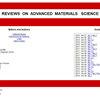Experimental study on the seismic performance of short shear walls comprising cold-formed steel and high-strength reinforced concrete with concealed bracing
IF 3.6
4区 材料科学
Q2 MATERIALS SCIENCE, MULTIDISCIPLINARY
引用次数: 0
Abstract
Abstract This study investigates the seismic performance of a composite structure comprising cold-formed steel and high-strength concrete. Four short shear walls composed of cold-formed steel and high-strength concrete, namely, one specimen without diagonal bracing, one with angle-steel bracing, and two with lattice bracing, were designed for testing their low cyclic loading. The cracking load, ultimate displacement, maximum horizontal bearing capacity, failure process, hysteretic curve, and skeleton curve of the four specimens were obtained during the test. The results showed that the use of cold-formed steel-concealed bracing in the high-strength concrete short shear wall can effectively change the failure mode of the wall into bending shear failure with good ductility. An analysis of the energy dissipation of the four specimens revealed that the energy dissipation capacity and ductility of high-strength concrete short shear wall with cold-formed steel concealed bracing were improved, indicating that the use of cold-formed steel concealed bracing greatly improved the total energy dissipation capacity of high-strength concrete short shear wall. The calculated shear bearing capacity in the diagonal section of the wall with concealed bracing was compared with the measured one. Considering specifications, a formula for calculating the shear capacity in the oblique section of short shear wall with concealed bracing was proposed.冷弯型钢-高强混凝土隐撑短剪力墙抗震性能试验研究
摘要本文研究了冷弯型钢与高强混凝土组合结构的抗震性能。设计了4个由冷弯型钢和高强混凝土组成的短剪力墙,即1个无斜撑、1个有角钢撑、2个有格构撑的试件,进行了低循环荷载试验。得到了4个试件的开裂荷载、极限位移、最大水平承载力、破坏过程、滞回曲线和骨架曲线。结果表明:在高强混凝土短剪力墙中采用冷弯型钢隐伏支撑可以有效地将墙体破坏模式转变为延性良好的弯剪破坏。通过对4个试件的耗能分析发现,采用冷弯型钢隐蔽支撑的高强混凝土短剪力墙的耗能能力和延性均有所提高,说明冷弯型钢隐蔽支撑的使用大大提高了高强混凝土短剪力墙的总耗能能力。将计算的隐支墙斜截面抗剪承载力与实测值进行了比较。考虑规范要求,提出了隐支短剪力墙斜截面抗剪承载力计算公式。
本文章由计算机程序翻译,如有差异,请以英文原文为准。
求助全文
约1分钟内获得全文
求助全文
来源期刊

Reviews on Advanced Materials Science
工程技术-材料科学:综合
CiteScore
5.10
自引率
11.10%
发文量
43
审稿时长
3.5 months
期刊介绍:
Reviews on Advanced Materials Science is a fully peer-reviewed, open access, electronic journal that publishes significant, original and relevant works in the area of theoretical and experimental studies of advanced materials. The journal provides the readers with free, instant, and permanent access to all content worldwide; and the authors with extensive promotion of published articles, long-time preservation, language-correction services, no space constraints and immediate publication.
Reviews on Advanced Materials Science is listed inter alia by Clarivate Analytics (formerly Thomson Reuters) - Current Contents/Physical, Chemical, and Earth Sciences (CC/PC&ES), JCR and SCIE. Our standard policy requires each paper to be reviewed by at least two Referees and the peer-review process is single-blind.
 求助内容:
求助内容: 应助结果提醒方式:
应助结果提醒方式:


